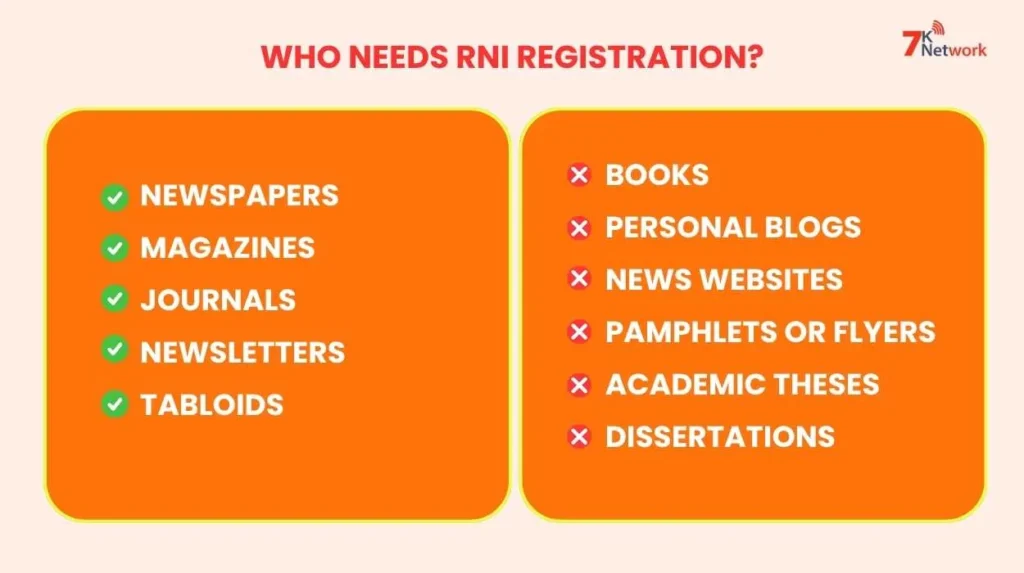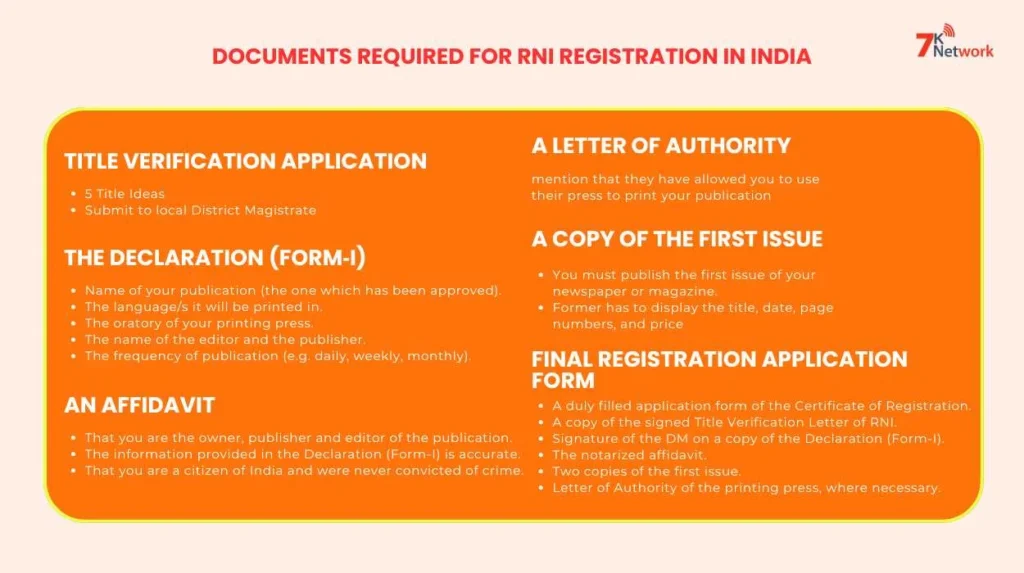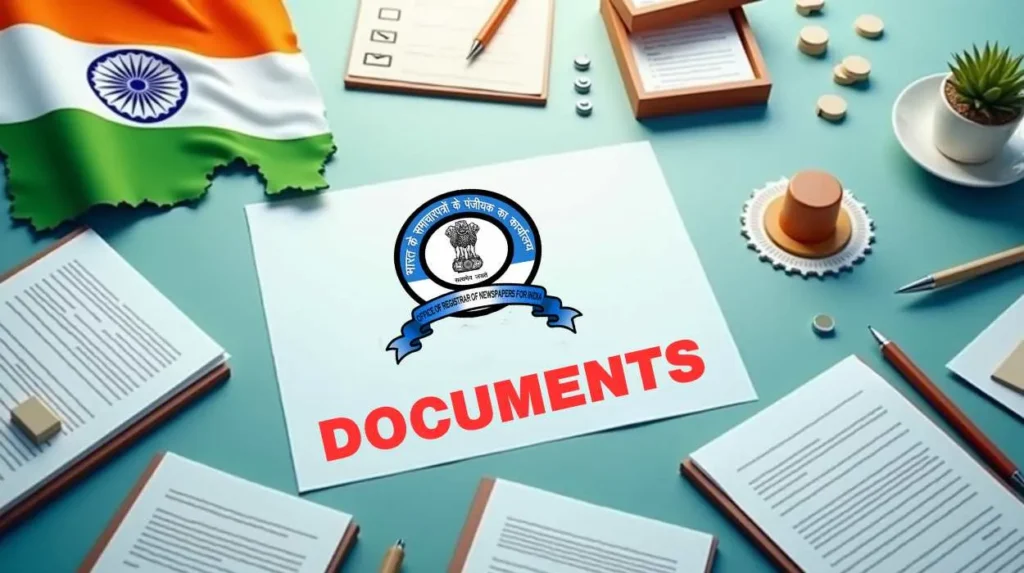Have you ever considered starting up your own newspaper or magazine? Perhaps a newspaper of your town once a week, or a monthly magazine on your hobby of interest, or a school paper. It’s an exciting idea! However, in the same way that every individual must have a birth certificate to identify him or herself, every newspaper or magazine in India must be officially registered. Such registration is referred to as RNI Registration.
If you are planning to register your publication, it’s important to know the Documents Required for RNI Registration in India to ensure a smooth and hassle-free process. RNI is the abbreviation of the Registrar of Newspapers to India. Consider the RNI office as the central office which monitors all the newspapers and magazines published in the country. It is their obligation to ensure everything is in order and that all the rules are observed.
To give you an idea of the size of the print world in India the following are some interesting figures:
- India has more than 145,000 registered periodicals and newspapers as per the latest reports. And that is a tremendous number of publications!
- The state having the most number of publications made is Uttar Pradesh which depicts the love of people in reading and publishing in that state.
- Newspapers and magazines In India, Hindi is the most popular language in which thousands of newspapers and magazines are printed daily.
- Despite the internet, the list of registered publications in India continues to expand by several thousand annually, indicating that individuals still prefer to hold a real newspaper or magazine in their hands.
These figures indicate that the establishment of a publication is a significant and widespread venture in India. This paper will be your happy companion, and it will tell you all about RNI registration in as simple a manner as possible. Today, 7k Network will take you through every single step, starting with the initial form that you will fill in and ending with the certificate that you will be awarded.
What is RNI and Why is it important?
Let’s break down what RNI is. RNI, which is the abbreviated form of the office of the Registrar of Newspapers to India, was established by the Government of India as far back as 1956. Its primary duty is to maintain a complete list or a register of all the publications in India.
Consider it as such: In your school there is a register with the name and roll number of all the students. This assists the school to monitor all individuals. Similarly, the name and registration number of all individual newspapers, magazines, journals, and newsletters published in India are registered in the RNI.
This registration is through a law known as the Press and Registration of Books (PRB) Act, 1867. It is quite an ancient law, yet still very vital. It has established all the rules publishers should adhere to.
The relevance of good documentation.
Being an RNI-registered is not a matter of doing what is required of a person. As a publisher, it has numerous advantages.
1. It Gives You a Unique Identity:
The approval of the name of your publication, or title, is the most significant aspect of the RNI process. RNI verifies its whole list to ensure that it is not in use by another person with the same name. When you title is granted, it is rightfully yours. This will help avoid confusion and guard against your brand.
2. It Makes Your Publication Legal:
Your newspaper or magazine is not regarded as legal without an RNI registration. You are not able to print and sell it to the people. The registration is important because you are publishing within the legal boundaries and the government has allowed you to publish.
3. It instills Confidence in Readers and Advertisers:
When individuals discover that your magazine has an official registration number of RNI, then they are certain that it is a serious and legitimate magazine. This builds trust. Most publications also make money by offering advertisements to businesses that are well registered.
4. It Helps you receive Government benefits:
Sometimes registered publications receive government benefits. As an illustration, India post may offer them reduced postal rates to send their copies to subscribers. They can also be the beneficiary of government advertisements, which can be a good income earner.
5. It Is Required to have a Press Card:
You must have a valid RNI registration in case you want to issue press identification cards to your reporters and journalists. These cards assist your team to gain entry to events and news scenes.
Check-out Our In depth Information on RNI Registration.
Who Needs RNI Registration?

Then, who must go through this process? The rule is simple.
In case you are publishing a periodical, you require RNI registration.
What is a periodical? Periodical is any publication that is published on a regular basis. This includes:
- Newspapers: Are they daily (Dailies), weekly or bi-weekly.
- Magazines: These may be weekly, fortnightly (after every two weeks), monthly, quarterly (after every three months), and even annual.
- Journals: The journals are usually specialized in a certain topic such as science, art or academics.
- Newsletters: This can be a little newsletter that you are going to print and make regular distributions.
- Tabloids: Tabloids are also a newspaper, and they should be registered.
In essence, when you have a fixed title in your publication, you are printed and released on a regular basis (daily, weekly, monthly, etc.), then you have to register the publication with the RNI. This is regardless of the language you publish in whether it is English, Hindi, Tamil, Bengali or any other Indian language. It is also irrelevant whether it is a large national or a small local magazine in the neighborhood. Everyone is equally subject to the rule.
Read Also: मान्यता प्राप्त पत्रकार कैसे बने?
Who Does Not Need RNI Registration?
Nor is it without knowing who need not register. You do not require registration of RNI of:
- Books: A book is published once and is not released regularly.
- Personal Blogs or News Websites: RNI registration is done on printed publications. The content online is not subject to this law.
- Pamphlets or Flyers: The one-time advertisements or information sheets are not regarded as periodicals.
- Academic Theses or Dissertations: It is not an academic periodical, but an academic work.
The most important thing is, however, the word periodical. When you are printing something that you are going to make available to the masses on a regular basis, you will need to have it registered.
Also Read: Top Indian Journalists
Minor Eligibility Requirements: Are You Prepared to Apply?
There are certain basic conditions that you must satisfy before you begin the process. These are the basic rules that have been established by the government so that the individuals in charge of publications are responsible.
This is the list of the people who can become a publisher or an owner of a newspaper in India:
- You Must Be an Indian Citizen: An individual who owns and publishes the newspaper has to be a citizen of India.
- You Cannot Be a Minor: You should be 18 years or above.
- You Should Have a Good Record: You should not have been found guilty by any court of any crime involving violence or some action that is against the country. This is to ensure that the power of press is in good hands.
- The Companies Can Be Applied as well: A company or a partnership firm can also be a newspaper owner, however, it should be a registered company in India. Individuals operating the company also should fit the requirements of eligibility.
These are the principal requirements. They are very simple and are aimed at making sure that it is the responsible Indian citizens who run the publishing world.
Critical Forms needed to register RNI.

The most significant aspect of the RNI process is likely to be getting all your paperwork in order. With proper and complete Documents Required for RNI Registration in India, the process will be much smoother and hassle-free. Imagine the preparation of all the ingredients before you begin to cook a meal.
The following is a bare list of the documents you will require. We are going to describe the purpose of each one of them.
1. The Title Verification Application.
This is the original document. It is a type in which you propose some names to your new newspaper or magazine. You are required to give 3-5 name choices. You submit this to your local District Magistrate (DM) who in turn submits the same to the RNI office in Delhi. The RNI will also verify whether or not any of the names you proposed is in use.
2. The Declaration (Form‑I)
After you have a title granted to you, you must declare it. It is a legal declaration before the District Magistrate (DM) or a local body of such kind. You say in this assertion:
- Name of your publication (the one which has been approved).
- The language/s it will be printed in.
- The oratory of your printing press.
- The name of the editor and the publisher.
- The frequency of publication (e.g. daily, weekly, monthly).
You are literally committing an oath that everything you are telling is valid. It is done on a special form known as Form-I.
3. An Affidavit
An affidavit refers to a written statement which is sworn to be true. It must be notarized (stamped and signed by a special legal officer known as a Notary Public). The RNI registration affidavit normally covers the following points:
- That you are the owner, publisher and editor of the publication.
- The information provided in the Declaration (Form-I) is accurate.
- That you are a citizen of India and were never convicted of crime.
- A special declaration that there is no foreign connection or investment in your publication (that there are separate and stricter rules to that).
Consider an affidavit to be a pinky promise on a document. It gives heft to your statement.
4. A Letter of Authority
This is required when the publication is owned by another party other than the person who prints it. Consider an example of a case where you are the owner of the magazine, and you have contracted a printing press to print your magazine on your behalf, you will be required to get a letter from the owner of the printing press. In this letter, they must mention that they have allowed you to use their press to print your publication.
5. A Copy of the First Issue
This is an important step. After signing your declaration by the DM you must publish the first issue of your newspaper or magazine. We call this the “pilot issue.” It should be printed at a particular time.
- When you have a daily or weekly paper, print the first one within 42days of the declaration signing.
- In case it is monthly or lower, print it in 90 days.
The former has to display the title, date, page numbers, and price. It should also have an imprint line that should contain: Printed and published by [Your Name] at [Address of the Printing Press].
6. The Final Registration Application Form
When the first issue is published, collect all the papers for the final application. Include:
- A duly filled application form of the Certificate of Registration.
- A copy of the signed Title Verification Letter of RNI.
- Signature of the DM on a copy of the Declaration (Form-I).
- The notarized affidavit.
- Two copies of the first issue.
- Letter of Authority of the printing press, where necessary.
Forward the whole package to the office of RNI New Delhi. Providing that all is in order they will give you your official RNI Registration Certificate.
The 10 Most Frequent Errors in RNI Documentation (And How to prevent them).
With small mistakes in the paperwork the RNI process may be delayed. Imagine it is a step in a recipe that has been missed–it can be a disaster. The most frequent errors and their prevention are provided below.
Common Mistakes
1. Ineffective Names and Addresses.
- The error: You have written your name in minor variants in various documents (e.g. V. Kumar in the application and Vinod Kumar in the affidavit). Or one form with your home address and another form with your office address without being explicit.
- Why it is a Problem: RNI must have all the information matching. Any discrepancy however negligible causes them to believe that there is something wrong and they will reject your application.
2. Mistakes in the Declaration Form (Form-I).
- The Error: Completing the form using wrong information, e.g. the wrong periodicity (e.g. write monthly when you intend to write weekly) or wrong printing press address.
- Why it is a Problem: The statement is a legal one. The information on it should be consistent with the information on your first issue and all other documents. In case the periodicity of your form is monthly and the first issue is weekly, then your application will be rejected.
3. Failure to meet Publication Deadlines.
- The Error: The first issue was not printed within the specified period (42 days in the case of weeklies, 90 days in the case of others) upon the signing of the declaration by the DM.
- Why it is a Problem: The time frame on this deadline is extremely rigid in the law. Failure to do it in time means that your declaration is invalid. This will require the declaration process to be repeated all over again thus, another visit to the DM office.
4. First Issue Does Not Play by the Rules.
- The Error: First of all, the first problem is the lack of some important details. The number of volumes (which must be Volume 1, issue 1 in the first instance) is frequently omitted, the date of the issue (Volume 1, Issue 1, full date) is omitted as well as the line of the imprint.
- Why it is a Problem: The initial evidence is the primary evidence that you have begun publishing. It should have all the elements needed to qualify as a valid publication.
5. Unfinished or Incomplete Affidavit
- The Error: Filing an affidavit that is not signed and stamped by a Notary Public, or contains a statement that does not have all the statements.
- Why it is a Problem: An affidavit that is not notarized is nothing more than a piece of paper that has no legal effect. It should be duly notarized in order to be accepted.
Tips to Avoid These Mistakes
- Check And Check again: It is best to check your document twice or thrice before putting it in. Look at spelling errors, particularly in name and address. Get someone, a friend or a family member to look at it. New eyes will notice a mistake that you have overlooked.
- Be Consistent: Choose a method of writing your name and an address to write all official communications and use it throughout.
- Prepare a Checklist: Prepare a basic checklist of all the documents required and all the information that has to be provided. Cross out the items as they are done.
- Mark Your Calendar: Once your declaration is signed by the DM, cross the final date on which you will publish your first issue onto a calendar in large and bold letters. Make phone reminders not to forget.
- Research: Have a look at a sample of another published newspaper or magazine. Note the manner in which they have printed their title, date and imprint line. Use it as a template of your initial issue.
- Not Rushing the Notary: To the notary, do not leave without making sure that they do the job well. Ensure that they stamp and sign.
It can take you a few minutes of time to be careful of your documents which could save you weeks or even months of delay. Rather than going fast and error-prone, it is always more advantageous to be slow and steady.
Step-by-Step Process of Getting Your RNI Registration
At this point, we will discuss all the stages of the process. We have separated it into distinct steps.
Stage 1: Selecting a Name and Validating it.
This is where your thoughts will begin to come to reality.
Step 1: Pick a good name
First, select the title of your publication. Be creative but realistic. The name must be memorable. List at least five or six names that you like in order of their liking.
Step 2: Make an application to have your title checked.
Complete the title verification form online on RNI site. Give your selected titles, language of publication, frequency of publication and your personal information.
Step 3: Intermediate to the District Magistrate (DM).
Make a copy of the online form and submit it to the office of your local District Magistrate. The DM will look into the application and send the same to the RNI head office in New Delhi.
Step 4: RNI checks the title
The DM submits the application to the RNI. They check their database to determine whether the names that you proposed are available. They verify names that are similar or sound similar to the existing ones.
Step 5: Obase Title Verification Letter.
In case one of your recommended names is not in use, the RNI accepts it and provides a Title Verification Letter to the DM. Your office will inform you, the DM. This letter demonstrates the name has now been secured to you. The title you have been approved for is a valid period of two years to help you in the next steps.
Stage 2: The Announcement at the Office of DM.
You have a name, now make it legal.
Step 6: Go to the DM’s Office
Having the Title Verification Letter, return to the office of DM. Complete the Form (Form-I).
Step 7: Sign the Declaration
The declaration is signed under the watch of the DM or any other authorized officer. It will also be signed, stamped and authenticated by the DM.
Stage 3: Publication of the First Issue.
It is the most thrilling step, now you print your first copy!
Step 8: Print the First Issue
Remember the deadline. Within 42 days (in the case of dailies and weeklies) or 90 days (in the case of others) after the date on which DM signed your declaration, you have to print the first issue of your newspaper or magazine.
Step 9: Make Sure it’s Perfect
Your vanity (Volume 1, Issue 1) should contain:
- The title approved on the first page.
- The issue number, volume number and date.
- The price (write Free, in case it is free).
- Page numbers on every page.
- The imprint line which is normally located at the bottom of the final page and contains the name of the publisher as well as the address of the printing press.
- Real content– articles, news or pictures. It cannot be blank.
Stage 4: Application to the Final certificate.
You are now in the homestretch now!
Step 10: Get Ready to Submit Your Final Application package.
Prepare all your papers documents: the last application form and the title verification letter and the authenticated declaration and your affidavit and two copies of your first issue.
Step 11: Send it to RNI
Send the whole package to the New Delhi office of the Registrar of Newspapers in India. Send it using a reputable service such as Speed Post to be able to trace it.
Stage 5: Final Wait and Approval.
Step 12: RNI Verification
The RNI officials will scrutinize each document that you have sent. They will verify that everything is the same and you were not breaking any rules.
Step 13: Take your RNI Registration Certificate!
In case all is well, a Certificate of Registration will be granted by the RNI. The certificate will contain the name of your publication and the official Registration Number of your publication. This is the number that your publication will have as its identity in life. The certificate is posted to your address of registration.
Congratulations! You are the legal publisher of an Indian registered publication.
How Long Does it All Take? (Typical Timelines)
RNI registration is a procedure that engages various departments in the government hence may take time. It is important to be patient. This is a rough estimate of the time per stage:
- Title Verification (Stage 1): This is normally the most time consuming. The RNI may also take 1 to 3 months and in other cases a long period before the approval letter is sent after you submit the application to your DM. This is subject to the workload of the RNI office and the speed at which your DM office passes the application.
- Declaration (Stage 2): It is typically fast to get an appointment with the DM and have the declaration signed. Depending on the schedule of the DM, it may take between a few days and 2 weeks.
- Stage 3: Publication: Do as you like. You are given a definite deadline of 42 or 90 days.
- Final Registration (Stage 4 & 5): Once you submit your full application package to the RNI in New Delhi, it may take them another 2 or 4 months to check all this out and grant you the final Registration Certificate.
Thus, it may take between 4 months and 8 months or even one year in between the day you first apply to the title and the day you finally get your final certificate provided there are no errors in your application that require correction. The point is to present flawless documents at the beginning in order not to lose time in vain.
We recommend you to utilize the Press Sewa Portal for online registration, which may streamline the process.
For Further assistant you may contact 7k Network at +9179057 27451.
Conclusion: Your Introduction to the World of Publishing
It is a strong move to start a newspaper or a magazine. You have access to exchanging stories, ideas and information with the world. The registration process of the RNI may sound tedious and may have much red tape in it, but it is a system that is meant to ensure that the world of Indian publishing remains fair and orderly.
When you have that RNI Registration Certificate in your hand, then you will be able to understand that you have created something concrete, legal and prepared to make its mark. It is the formal start of your new exciting career as a publisher, where you will have a voice to your ideas and a platform to your stories.
FAQs
1. Would that be possible to get my online site or blog registered under RNI?
No, RNI registration is only applied to published printed materials such as newspapers and magazines which are published regularly. It is not applicable in the case of online or digital content.
2. What will be the consequence of not releasing my first issue in time?
In case you fail to meet the deadline (42 or 90 days) to publish your first issue on the signature of the declaration, your declaration will be void. You will be obliged to revisit the office of the District Magistrate, and make another declaration.
3. And will I need my own printing press in order to obtain RNI registration?
No, you do not need to have a printing press. You may get your publication printed at any press. You will only need a letter by that printing press that they are printing your publication.
4. What is the cost of the RNI registration?
There is no official fee charged by the government on the very process of RNI registration. You will however need to spend a little money on such things as getting your affidavit notarized.


